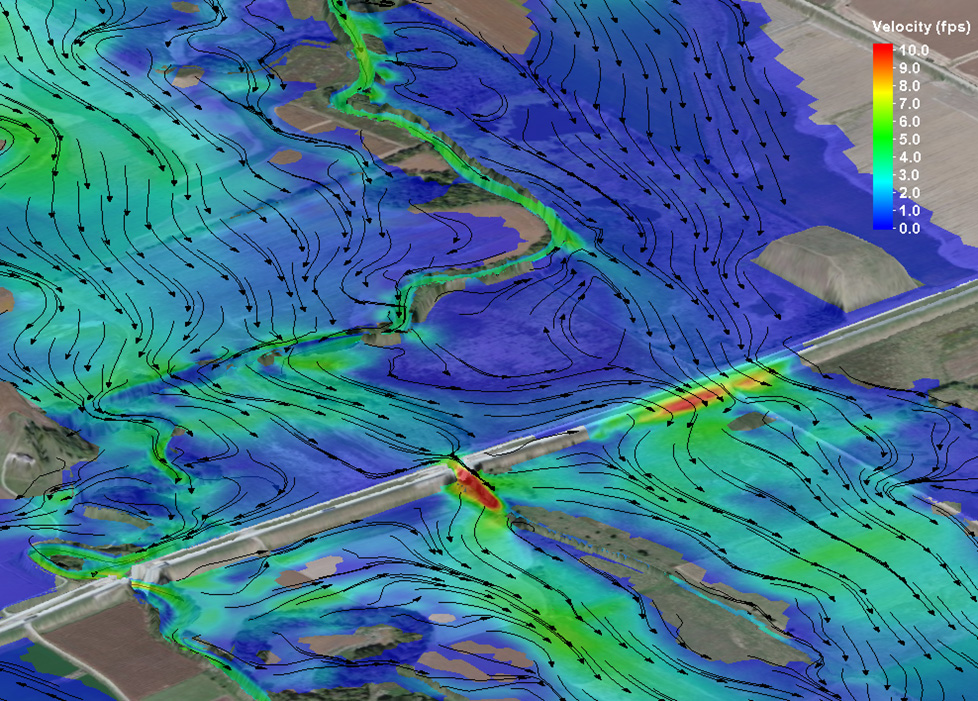November 29, 2018
Innovation of the Month:
Collaborative Hydraulics: Advancing to the Next Generation of Engineering
Transportation agencies participating in Collaborative Hydraulics: Advancing to the Next Generation of Engineering (CHANGE) are adopting modern hydraulic modeling tools that can lead to better design and more efficient delivery of projects involving waterways.
The Alaska Department of Transportation and Public Facilities (DOT&PF) is collaborating with partner agencies to use two-dimensional (2D) hydraulic modeling tools for hydraulic and scour analyses on bridges. For example, Alaska DOT&PF initiated a cooperative agreement with the U.S. Geological Survey (USGS) to apply 2D hydraulic modeling on bridge projects. The agreement outlines the process for USGS to perform 2D hydraulic analyses for Alaska DOT&PF, use the modeling results to determine the scour risk of structures, and communicate the results. The process provides Alaska DOT&PF with the best available information to develop any needed action plans for its structures to ensure the safety of the traveling public.
With the successful completion of 2D modeling pilot projects and the development of new guidance, the Arizona Department of Transportation (ADOT) has institutionalized CHANGE. When ADOT compared 2D and one-dimensional modeling tools, ADOT found that 2D modeling provided superior visualization of modeling results and more accurate representations of water surface elevations, velocities, and flooding extents.
Federal Lands Highway (FLH), which uses 2D hydraulic modeling for all new analyses in river and coastal environments, is applying the technology on several bridge projects for the National Park Service, U.S. Forest Service, and county agencies. FLH is using 2D modeling on projects involving single- and multiple-span bridges, bank stabilization, floodplain analysis, and multiple stream confluences.
Contact Scott Hogan of the Federal Highway Administration Resource Center for information and technical assistance.
Arizona Uses Adaptive Signal Control Technology to Decrease Travel Times
Drivers on a busy route in Pima County, AZ, are benefiting from adaptive signal control technology (ASCT), which adjusts traffic signal timing based on how many vehicles are on the road. The Arizona Department of Transportation (ADOT) installed an ASCT system on State Route 77, a north-south route connecting Tucson and Oro Valley that serves 60,000 vehicles a day. As a result, travel times over an 8.5-mile section of the road were reduced by about 10 percent—about 2 minutes off the morning southbound commute before ASCT installation. Northbound travel times have improved by 1 minute during the afternoon commute and up to 3 minutes earlier in the day. Because signals are timed to the speed limit during nonpeak hours, more drivers are traveling at the speed limit. For information, contact James Gomes of ADOT.
Seattle Improves Pedestrian Safety with Retroreflective Sleeves on Signs
As State and local agencies partner with FHWA to advance the Safe Transportation for Every Pedestrian initiative, the city of Seattle, WA, added retroreflective sleeves to about 5,000 of the city's 8,000 STOP and YIELD sign posts. The sleeve is a three-sided reflector that attaches to a sign post and matches the sign's background color. This low-cost, quickly installed treatment increases the visibility of the sign, especially during evening hours. The neighboring city of Shoreline adopted Seattle's approach for sign sleeves at crosswalks and intersections and the Washington State Department of Transportation began installing the sleeves on signs at curves and on/off ramps. The use of retroreflective sleeves is supported by FHWA's "Manual on Uniform Traffic Control Devices." For information, read "Can a Sleeve and a Gateway Improve Pedestrian Safety?" in the FHWA Safety Compass newsletter or contact Becky Crowe of the FHWA Office of Safety.
About EDC
Every Day Counts, a State-based program of the Federal Highway Administration’s Center for Accelerating Innovation, works with State, local, and private sector partners to encourage the adoption of proven technologies and innovations to shorten and enhance project delivery.



